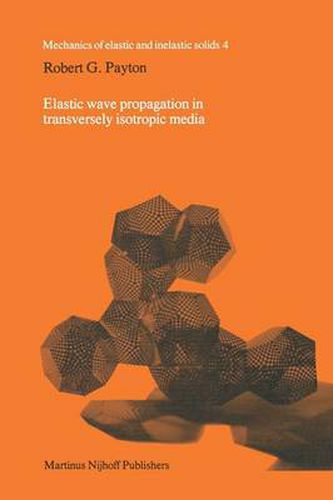Readings Newsletter
Become a Readings Member to make your shopping experience even easier.
Sign in or sign up for free!
You’re not far away from qualifying for FREE standard shipping within Australia
You’ve qualified for FREE standard shipping within Australia
The cart is loading…






This title is printed to order. This book may have been self-published. If so, we cannot guarantee the quality of the content. In the main most books will have gone through the editing process however some may not. We therefore suggest that you be aware of this before ordering this book. If in doubt check either the author or publisher’s details as we are unable to accept any returns unless they are faulty. Please contact us if you have any questions.
In this monograph I record those parts of the theory of transverse isotropic elastic wave propagation which lend themselves to an exact treatment, within the framework of linear theory. Emphasis is placed on transient wave motion problems in two- and three-dimensional unbounded and semibounded solids for which explicit results can be obtained, without resort to approximate methods of integration. The mathematical techniques used, many of which appear here in book form for the first time, will be of interest to applied mathematicians, engeneers and scientists whose specialty includes crystal acoustics, crystal optics, magnetogasdynamics, dislocation theory, seismology and fibre wound composites. My interest in the subject of anisotropic wave motion had its origin in the study of small deformations superposed on large deformations of elastic solids. By varying the initial stretch in a homogeneously deformed solid, it is possible to synthesize aniso tropic materials whose elastic parameters vary continuously. The range of the parameter variation is limited by stability considerations in the case of small deformations super posed on large deformation problems and (what is essentially the same thing) by the of hyperbolicity (solids whose parameters allow wave motion) for anisotropic notion solids. The full implication of hyperbolicity for anisotropic elastic solids has never been previously examined, and even now the constraints which it imposes on the elasticity constants have only been examined for the class of transversely isotropic (hexagonal crystals) materials.
$9.00 standard shipping within Australia
FREE standard shipping within Australia for orders over $100.00
Express & International shipping calculated at checkout
This title is printed to order. This book may have been self-published. If so, we cannot guarantee the quality of the content. In the main most books will have gone through the editing process however some may not. We therefore suggest that you be aware of this before ordering this book. If in doubt check either the author or publisher’s details as we are unable to accept any returns unless they are faulty. Please contact us if you have any questions.
In this monograph I record those parts of the theory of transverse isotropic elastic wave propagation which lend themselves to an exact treatment, within the framework of linear theory. Emphasis is placed on transient wave motion problems in two- and three-dimensional unbounded and semibounded solids for which explicit results can be obtained, without resort to approximate methods of integration. The mathematical techniques used, many of which appear here in book form for the first time, will be of interest to applied mathematicians, engeneers and scientists whose specialty includes crystal acoustics, crystal optics, magnetogasdynamics, dislocation theory, seismology and fibre wound composites. My interest in the subject of anisotropic wave motion had its origin in the study of small deformations superposed on large deformations of elastic solids. By varying the initial stretch in a homogeneously deformed solid, it is possible to synthesize aniso tropic materials whose elastic parameters vary continuously. The range of the parameter variation is limited by stability considerations in the case of small deformations super posed on large deformation problems and (what is essentially the same thing) by the of hyperbolicity (solids whose parameters allow wave motion) for anisotropic notion solids. The full implication of hyperbolicity for anisotropic elastic solids has never been previously examined, and even now the constraints which it imposes on the elasticity constants have only been examined for the class of transversely isotropic (hexagonal crystals) materials.